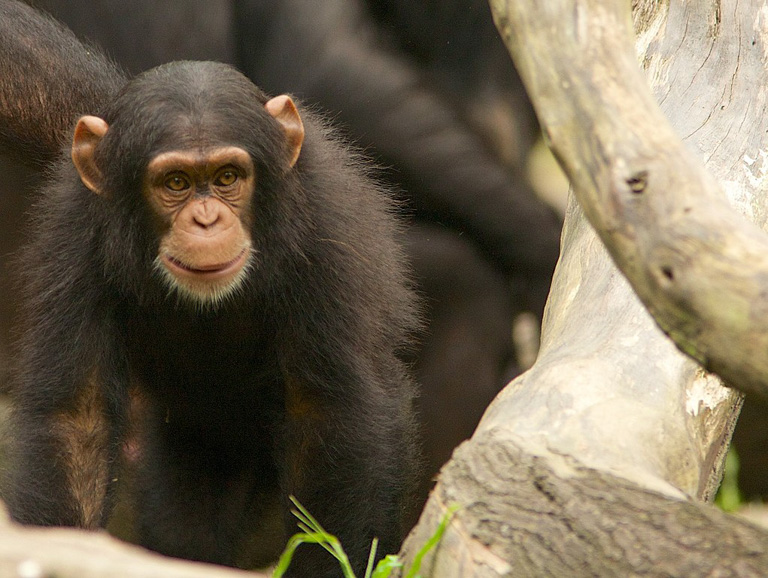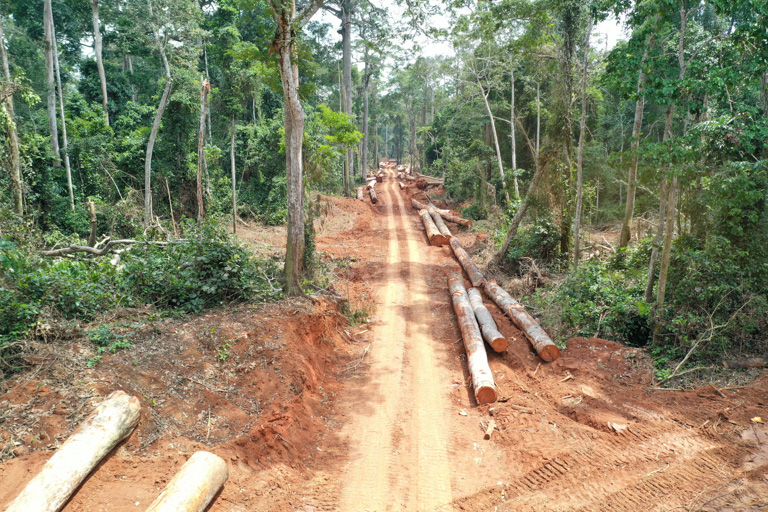- Researchers logged the first evidence of elephant poaching in a remote, pristine section of Nouabalé-Ndoki National Park in the northern Republic of Congo.
- The study, published in the journal Frontiers in Forests and Global Change, also revealed unique behavior changes between gorillas and chimpanzees as a result of selective logging.
- The research highlights the need to incorporate the results of biodiversity surveys into plotting out the locations of areas set aside for conservation.
Elephant poachers are using logging roads to infiltrate some of the last remaining pristine forests in Central Africa, according to a study published in July.
The study’s authors also revealed that logging, even done selectively under Forest Stewardship Council (FSC) guidelines, alters wildlife habitat and behavior. The research, published in the journal Frontiers in Forests and Global Change, examined how these changes altered the habitat for western lowland gorillas (Gorilla gorilla gorilla) and central chimpanzees (Pan troglodytes troglodytes).
It turns out that the impacts are “quite different” for each ape, said David Morgan, a conservation scientist at Chicago’s Lincoln Park Zoo and the paper’s lead author.

Working with the logging companies and local officials, Morgan and his colleagues picked out the intact forest landscapes (IFLs) — defined as areas 500 square kilometers (193 square miles) or larger without signs of human use — on satellite maps in Nouabalé-Ndoki National Park and an adjacent, FSC-certified logging concession in the northern Republic of Congo. They then identified, counted and measured the sizes of plants in plots both inside intact forest landscapes and in logged areas.
The team also estimated how easy it was for humans to access the study area based on the roads cutting through it, and they incorporated the observations of the presence of humans from local research teams and wildlife patrols.
The goal was to provide a window into the current state of the habitat for gorillas and chimpanzees as well as changes coming down the road.
“With this type of data, we can start to think about distance from roads, what the tree resources are and how those changes are going to affect them long term,” Morgan said in an interview. The IUCN lists western gorillas as critically endangered and central chimpanzees as endangered.

Central Africa’s once-vast tracts of unbroken rainforest have dwindled precipitously in recent decades, primarily due to logging. A 2017 study found that Central Africa lost about a tenth of its IFLs between 2000 and 2013. Alongside the thinning and clearance of these forests has been a startling uptick in the expansion of logging roads throughout the area. Ecologists calculated in a 2019 paper that the length of roads in the Congo Basin in 2018 was more than two-and-a-half times what it was in 2003.
The comparisons of logged areas and IFLs revealed little difference in the numbers of chimpanzees and gorillas between the two habitats. However, they found that the shift in the mix of plant species present did change the apes’ foraging tendencies.
Their analysis provided further evidence that these changes to the forest affect the animals differently. Previous research led by Morgan suggested that gorillas stand a better chance of coping with selectively logged forests than chimpanzees because their diets are more flexible and they aren’t as territorial.
In this case, Morgan and his colleagues learned that chimps built their nests closer to the ground in logged areas than they did in IFLs, a change not observed in gorillas. That could, Morgan speculated, increase the chance of spreading disease in a population, though that wasn’t something the team looked at in this study.

Most concerning was the discovery that elephant poachers had begun to make their way into the dense IFLs in the logging concession and in the park, likely aided by a proliferation of logging roads nearby. The illicit ivory trade has pushed the forest elephant (Loxodonta cyclotis) population in the Congo Basin into a nosedive. Between 2002 and 2011, researchers tracked a 62 percent drop in the numbers of the smaller cousin to Africa’s savanna elephants, which many scientists now recognize as a distinct species.
Morgan and other ape researchers have been studying this area since the late 1990s, especially the Goualougo Triangle, which forms the southern tip of Nouabalé-Ndoki National Park.
When the research first started, Morgan said, “There were no signs of people in that area.”
“That was kind of the red line,” he said of the Goualougo Triangle. “You can’t let places like this become open to poachers. We have to do all we can to protect that.”

To do that, the authors highlight the need to incorporate these types of biodiversity assessments that look at the long-term changes to habitats and the impacts on wildlife when plotting out where to set aside land for conservation or protected areas. Such forward-thinking planning is particularly important in places that don’t have the level of protection that Nouabalé-Ndoki National Park does.
It appears that even the park, which is part of the Sangha Trinational UNESCO World Heritage site stretching across the Republic of Congo, the Central African Republic and Cameroon, may face further challenges: in 2018, the government of the Republic of Congo invited oil companies to bid on exploration rights in a block of land overlapping with the park.
Oil exploitation “doesn’t fit” with the region’s World Heritage status, Morgan said.
Still, he added, “This one of the most well-protected, well-funded parks in Central Africa,” but the team’s research demonstrates that it’s still susceptible to poachers. “If it’s occurring here, it’s going to be occurring in other areas that aren’t being monitored as much.”
Banner image of forest elephants by Richard Ruggiero/U.S. Fish and Wildlife Service Headquarters via Wikimedia Commons (Public domain).
John Cannon is a staff writer at Mongabay. Find him on Twitter: @johnccannon
Citations:
Maisels, F., Bergl, R.A., & Williamson, E.A. (2018). Gorilla gorilla (amended version of 2016 assessment). The IUCN Red List of Threatened Species 2018: e.T9404A136250858. http://dx.doi.org/10.2305/IUCN.UK.2018-2.RLTS.T9404A136250858.en. Downloaded on 02 October 2019.
Maisels, F., Strindberg, S., Greer, D., Jeffery, K., Morgan, D.L., & Sanz, C. (2016). Pan troglodytes ssp. troglodytes (errata version published in 2016). The IUCN Red List of Threatened Species 2016: e.T15936A102332276. http://dx.doi.org/10.2305/IUCN.UK.2016-2.RLTS.T15936A17990042.en. Downloaded on 02 October 2019.
Morgan, D., Strindberg, S., Winston, W., Stephens, C. R., Traub, C., Ayina, C. E., … Sanz, C. M. (2019). Impacts of Selective Logging and Associated Anthropogenic Disturbance on Intact Forest Landscapes and Apes of Northern Congo. Frontiers in Forests and Global Change, 2, 28. doi:10.3389/ffgc.2019.00028
FEEDBACK: Use this form to send a message to the author of this post. If you want to post a public comment, you can do that at the bottom of the page.
